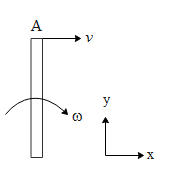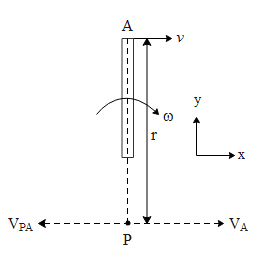
Find the instantaneous axis of rotation of a rod of length l when its end A moves with velocity ${{v}_{\text{A}}}=v\widehat{i}$ and the rod rotates with angular velocity $\omega =-\dfrac{v}{2l}\widehat{k}$


Answer
519.9k+ views
Hint: To find the instantaneous axis of rotation of a rod of length l, we first need to locate the ICR i.e. the instantaneous centre of rotation. The velocity of this point is always relatively taken to be zero. Hence further expressing the different components of velocities at this point we will obtain the instantaneous axis of rotation of a rod of length l with respect to its end A.
Formula used:
$v=\omega r$
Complete step-by-step answer:
First let us take a point P as the ICR in the extended version of the rod. The relative velocity of this point is always zero. Given below is a figure to understand the location of ICR.

The velocity of the point P is zero. Hence from the above figure we can write
$\begin{align}
& {{v}_{P}}={{v}_{PA}}+{{v}_{A}} \\
& \because {{v}_{P}}=0 \\
& \therefore {{v}_{PA}}+{{v}_{A}}=0.....(1) \\
\end{align}$
The velocity with which the point P moves is equal to ${{v}_{\text{A}}}=v\widehat{i}$ and the velocity with which the point A moves with respect to P is ${{v}_{\text{PA}}}=\omega r\widehat{i}$ where ‘r’ is the distance of point P from point A.
Hence from equation 1 we obtain,
$\begin{align}
& {{v}_{PA}}+{{v}_{A}}=0 \\
& \Rightarrow \omega r\widehat{i}+v\widehat{i}=0 \\
& \therefore v=\omega r \\
\end{align}$
In the question it is given that the rod rotates with angular velocity equal to $\omega =-\dfrac{v}{2l}\widehat{k}$. Therefore from the above equation we obtain the position of the instantaneous axis of rotation with respect to A at,
$\begin{align}
& v=\omega r \\
& \Rightarrow v=-\dfrac{v}{2l}r \\
& \therefore r=2l \\
\end{align}$
Hence the instantaneous axis of rotation of a rod lies at 2l from end A of the rod.
Note: Instantaneous center of rotation (ICR) is an imaginary point about which a link is assumed to rotate. This point has certain properties which can be used to simplify the motion of the body. This point may lie or sometimes may not lie on the body.
Formula used:
$v=\omega r$
Complete step-by-step answer:
First let us take a point P as the ICR in the extended version of the rod. The relative velocity of this point is always zero. Given below is a figure to understand the location of ICR.

The velocity of the point P is zero. Hence from the above figure we can write
$\begin{align}
& {{v}_{P}}={{v}_{PA}}+{{v}_{A}} \\
& \because {{v}_{P}}=0 \\
& \therefore {{v}_{PA}}+{{v}_{A}}=0.....(1) \\
\end{align}$
The velocity with which the point P moves is equal to ${{v}_{\text{A}}}=v\widehat{i}$ and the velocity with which the point A moves with respect to P is ${{v}_{\text{PA}}}=\omega r\widehat{i}$ where ‘r’ is the distance of point P from point A.
Hence from equation 1 we obtain,
$\begin{align}
& {{v}_{PA}}+{{v}_{A}}=0 \\
& \Rightarrow \omega r\widehat{i}+v\widehat{i}=0 \\
& \therefore v=\omega r \\
\end{align}$
In the question it is given that the rod rotates with angular velocity equal to $\omega =-\dfrac{v}{2l}\widehat{k}$. Therefore from the above equation we obtain the position of the instantaneous axis of rotation with respect to A at,
$\begin{align}
& v=\omega r \\
& \Rightarrow v=-\dfrac{v}{2l}r \\
& \therefore r=2l \\
\end{align}$
Hence the instantaneous axis of rotation of a rod lies at 2l from end A of the rod.
Note: Instantaneous center of rotation (ICR) is an imaginary point about which a link is assumed to rotate. This point has certain properties which can be used to simplify the motion of the body. This point may lie or sometimes may not lie on the body.
Recently Updated Pages
Master Class 11 Chemistry: Engaging Questions & Answers for Success

Why are manures considered better than fertilizers class 11 biology CBSE

Find the coordinates of the midpoint of the line segment class 11 maths CBSE

Distinguish between static friction limiting friction class 11 physics CBSE

The Chairman of the constituent Assembly was A Jawaharlal class 11 social science CBSE

The first National Commission on Labour NCL submitted class 11 social science CBSE

Trending doubts
What is meant by exothermic and endothermic reactions class 11 chemistry CBSE

10 examples of friction in our daily life

One Metric ton is equal to kg A 10000 B 1000 C 100 class 11 physics CBSE

Difference Between Prokaryotic Cells and Eukaryotic Cells

What are Quantum numbers Explain the quantum number class 11 chemistry CBSE

1 Quintal is equal to a 110 kg b 10 kg c 100kg d 1000 class 11 physics CBSE




